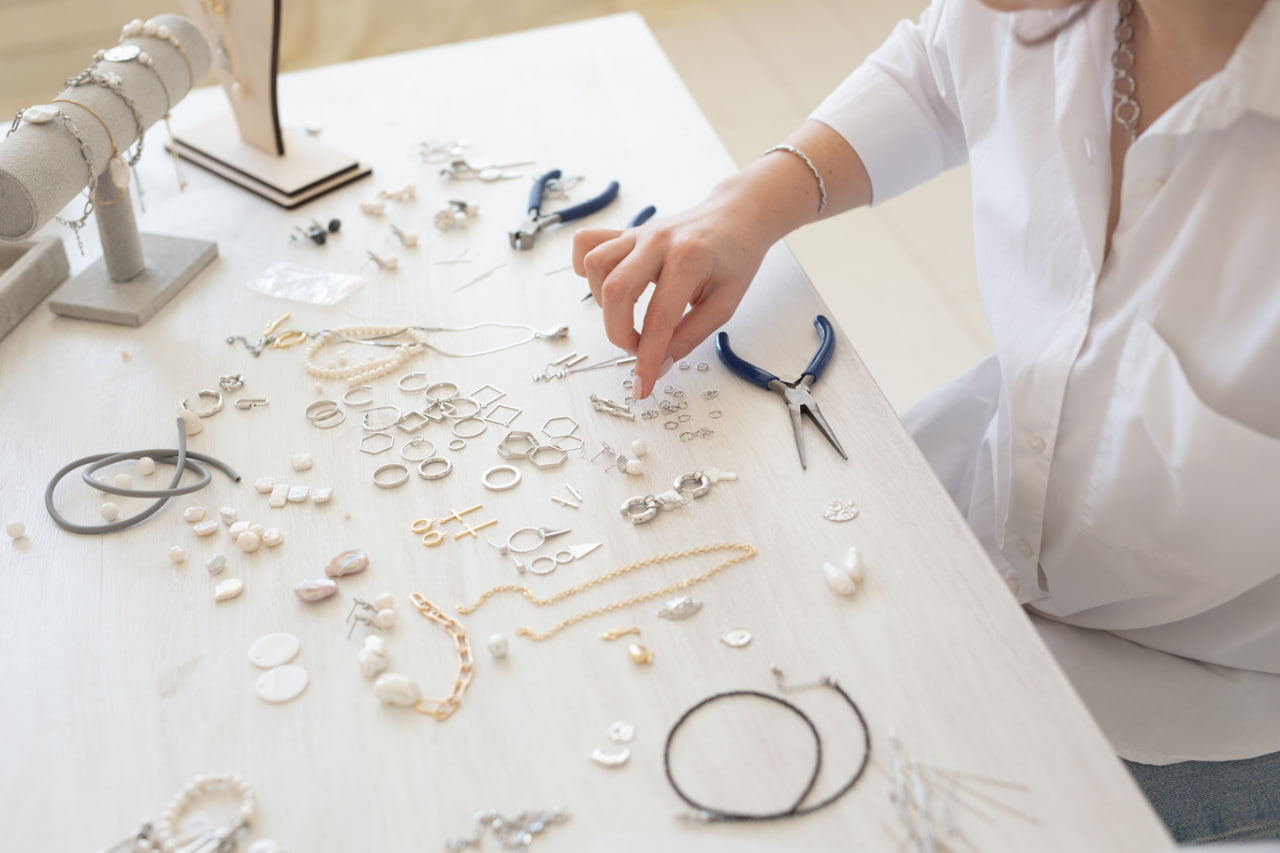Introduction to Jewelry Materials
Creating handmade jewelry begins with understanding the core materials: beads, metals, and gemstones. Each material has unique properties, applications, and techniques, and learning how to work with them is essential for producing durable, beautiful pieces. Beads offer versatility and color variety, metals provide structure and support, and gemstones add elegance and visual impact.
Understanding the characteristics of each material helps beginners choose the right combination for their designs. This knowledge also reduces mistakes, prevents material damage, and ensures a professional finish in every creation.
Exploring Beads and Their Uses
Beads are among the most accessible materials for beginners. They come in various shapes, sizes, and materials including glass, wood, ceramic, and plastic. Beads can serve as the main decorative element or complement other components like metal findings or gemstones.
- Seed Beads – Tiny, uniform beads ideal for intricate patterns, embroidery, and delicate necklaces or bracelets.
- Glass and Crystal Beads – Offer sparkle and color, perfect for adding elegance to earrings and pendants.
- Wood and Natural Beads – Provide texture and an earthy feel, often used in bohemian or rustic jewelry.
- Acrylic and Resin Beads – Lightweight and affordable, allowing experimentation with colors and shapes.
Arranging beads in thoughtful patterns, alternating sizes and colors, or combining textures creates visual interest and enhances the overall design.
Working with Metals
Metals are the backbone of most jewelry, providing structure, stability, and a framework for beads and gemstones. Common metals include silver, gold, copper, brass, and stainless steel, each with unique properties.
- Wire Work – Wire is used for wrapping, shaping, and connecting components. Gauge selection affects flexibility and strength. Thinner wire is easier for detailed work, while thicker wire adds stability.
- Metal Findings – Clasps, jump rings, and earring hooks are essential for assembly and functionality. Choosing the right type and size ensures durability.
- Hammering and Texturing – Adding texture to metal surfaces creates visual depth and uniqueness. Techniques include stamping, hammering, and embossing.
Understanding how to manipulate metals safely and effectively allows beginners to create functional and aesthetically pleasing jewelry pieces.
Introduction to Gemstones
Gemstones provide a focal point and add elegance to jewelry. They can be precious, semi-precious, or synthetic, and each has different hardness, weight, and color properties. Selecting gemstones appropriate for the design and intended use is essential for both beauty and durability.
- Precious Gemstones – Diamonds, rubies, sapphires, and emeralds, known for high value and brilliance.
- Semi-Precious Gemstones – Amethyst, garnet, turquoise, and quartz, offering a wide range of colors and affordability.
- Cabochons and Faceted Stones – Cabochons are smooth and rounded, while faceted stones have flat, angled surfaces to reflect light.
- Gemstone Beads – Pre-drilled stones make assembly easier for necklaces, bracelets, and earrings.
Proper handling, setting, and securing of gemstones ensure the longevity of the jewelry and prevent damage during wear.
Tools for Beginners
Working effectively with beads, metals, and gemstones requires basic tools that enable precision, safety, and creativity. Essential tools include:
- Pliers – Round-nose, flat-nose, and chain-nose pliers for bending, shaping, and securing wire and findings.
- Wire Cutters – For trimming wire and other components cleanly.
- Beading Needles – Used for threading small beads or intricate patterns.
- Tweezers and Magnifiers – Help handle tiny components and inspect details closely.
Learning to use these tools correctly allows beginners to work efficiently, avoid mistakes, and achieve polished results.
Techniques for Combining Materials
Combining beads, metals, and gemstones requires understanding how materials interact. For example, heavier gemstones need thicker wire or additional support, while delicate beads may require fine wire or gentle handling.
- Stringing – Threading beads and gemstones onto wire, cord, or chain for necklaces and bracelets.
- Wire Wrapping – Securing gemstones and beads with wire for pendants, earrings, or focal points.
- Metal Connectors – Using jump rings, clasps, or links to combine materials securely and enhance design.
- Layering and Mixing Textures – Combining different materials adds depth, visual interest, and tactile appeal.
Experimentation and practice help beginners discover combinations that are both aesthetically pleasing and structurally sound.
Safety and Care
Safety is critical when working with metals, tools, and small components. Wear protective eyewear, handle sharp tools carefully, and ensure a stable workspace to prevent accidents. Proper storage of beads, gemstones, and metals reduces loss and damage.
Additionally, maintaining your finished jewelry through cleaning and careful handling ensures longevity. Metal components may tarnish over time, and gemstones can scratch or chip if not cared for appropriately.
Building Confidence Through Practice
Mastering beads, metals, and gemstones requires patience, experimentation, and consistent practice. Starting with simple projects allows beginners to learn basic techniques, while gradually increasing complexity builds confidence and skill.

